Melody Maps
What is a melody map?
It is a visual that represents a song. It’s colorful, creative, and helps to “make concrete” the sound of a song.
How do you use a melody map?
I usually ask, “What do you see? What do you notice?” After getting some ideas from the children, I ask, “What does this have to do with this song?” Then I sing the song again and again, asking questions to help the children discover what each of the symbols on the map mean.
We will then sing the song, having the children sing certain symbols, and I will sing the rest.
(Here is an idea for a Melody Map for If the Savior Stood Beside Me. If you want to see how to create a melody map, read on from here.)
I first show the children this poster and ask, “What do you see? What do you notice?” I then ask, “Can you find these symbols anywhere on this code map?” Often a child will then comment, “The yellow and gold circles aren’t up there!” It’s a good opportunity for me to say, “Listen to the song as I sing it and figure out what that symbol means.”
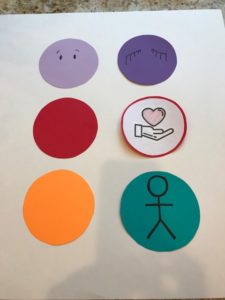
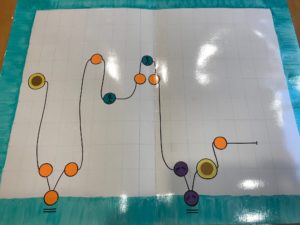
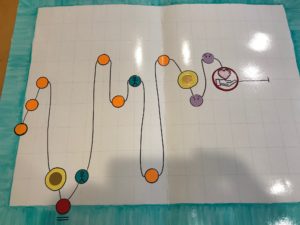
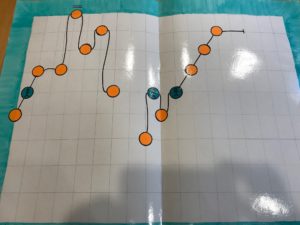
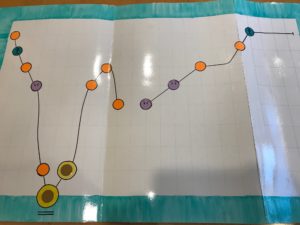
How do you make a melody map?
Here are few examples of different melody maps:
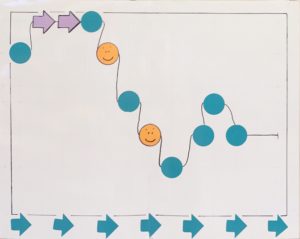
One of the phrases of As a Child of God
Here is a Melody map done on the computer: If I listen melody map
And another melody map idea for a phrase of the song, Come Follow Me
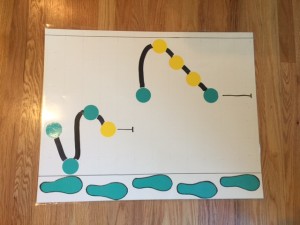
Come Follow Me
http://teachingprimarymusic.com/come-follow-me-melody-map-for-older-children/
Melody Maps
Melody Maps are colorful and fun for the children. They help them visualize sound. The maps help the children think and figure out a puzzle. But how do you make them?
Let’s take the song “If the Savior Stood Beside Me.”
I want to discover three things about the song so that I can make a melody map.
(To see the finished product so that you can visualize this process, go to the very bottom of this blog post. I mapped out the 3rd verse.)
The 3 questions
- What is the the melody range (how many notes from lowest to highest)?
- How many notes in a phrase are there ? (How many notes in the longest phrase is helpful)
- What are special words that can be represented visually?
That’s pretty much what you need to know about making a melody map! Here’s the details of how I made this particular map.
Melody Range (How many notes from lowest to highest?)
This song starts on the note G, but that’s not the highest note in the song. When I look for the highest note the children will sing, I see a C above middle C.
When I look for the lowest note in the song, I see a B below middle C.
If I count from B below Middle C to C above Middle C, I count 9 notes.
B=1, C=2, D=3, E=4, F=5, G=6, A=7, B=8, C=9
This means my melody map will have 9 different up and down places for notes on the page.
Notes in a Phrase (How many notes in the phrases?)
The first sentence, “If the Savior stood beside me, would I do the things I do?” has 15 notes that correspond with the words. That’s about as many as I can fit on a large poster board (which is large enough that the children at the back of the room can see).
The second sentence has 15 notes, also.
The third sentence only has 8 notes, and part of the next sentence have 15 notes. “Would I follow His example? Would I live more righteously…” (Those two together have 15 notes.)
The fourth part of the melody map has 15 notes in this part sentence. “…if I could see the Savior standing nigh, watching over me?”
Notes in a phrase = 15
This means my melody map will have 15 different sections (right to left) on the page.
Note: If you want to make smaller spaces for the eighth notes, and longer spaces for the dotted half notes, you will actually need 18 sections, one space for every beat.
(Here’s how that plays out:
one space for the pick up notes,
3 measures of 4 beat counts (12) plus 3 counts for the dotted half note for the first two posters/phrases.
That equals 15 sections or spaces.
The third poster for the third phrase will only use 14 spaces,
and the fourth poster will use 18 spaces because of the counting on the last part of the song.)
Don’t get overwhelmed by all that! Take a look at the pictures of the melody map below, and it will be more clear!<grin>
Special Words
What special words can I choose to help the children see where they might go in the melody?
In each of the verses, “I,” “me,” “my,” and other words that refer to myself are prominent. I am going to choose to represent those words with a stick figure inside a circle.
Also, references to the Savior (His, Him, He) are another repeated kind of word. I am going to represent those words with a gold dot surrounded by yellow. You could also put a printed small rectangle picture of the Savior.
Looking at Special Words is where you need to decide which verse you are going to present with the melody map. I have chosen to do the third verse in this example. Because of that I have also chosen the words:
“not see”, “loves”, “watchful/see/watching,” “care”. I’m going to represent those words with two eyes closed, a red dot, two eyes open, and a symbol for caregiver I got by searching on the internet.

Let’s talk about how this will look on a poster that is big enough for all of the children to see. (You could also do something on a computer and display it, but this discussion will focus on a poster board.)
Surrounding White Space
Each of the displayed posters are best quickly processed by the brain if there is some surrounding white space around the notes and word representation.
Most poster boards are 22 by 28 inches. I usually leave 1 1/2 inches around each edge (which takes off 3 inches from the space I am dividing). That means 19″ by 25″ is the space I’m working with for the melody map in order to leave some white space around the outside. The 19 inches will be divided up and down by 9 (melody range). The 25 inches will be divided by either 15 to 18 (notes in a phrase).
Warning! Don’t get blown away by this next section. You don’t have to be this precise, but in case you want to be, here are some details.
Technicalities: The number 9 goes well into 18, so I am going to make a 2 inch edge around the poster (which makes 22 minus 4 inches which equals 18). But, I want to have the numbering start 4 inches off of the bottom so that the #1 is actually 2 inches away from the border.
The number 24 is better divisible by 18 than 25 is, so a 2 inch border works better in this case also (which makes 28 minus 4 inches equals 24 inches).
Setting up the posters
Bottom to Top:
Inches: bottom 2″ for border, #1- 4″, #2- 6″, #3- 8″, #4- 10″, #5- 12″, #6- 14″, #7- 16″, #8- 18″, #9- 20″, top border is 2″. (There will only be two notes that go on this top line… the last of the third poster, and the first of the fourth poster.) Look closely and you can see the faint pencil lines.
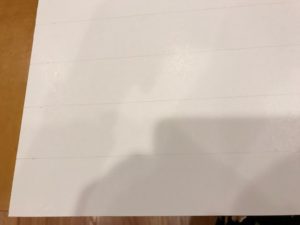
Side to Side:
Inches: Left side 2″ for border #1- 3.33″, #2- 4,66″, #3- 5.99″, #4- 7.33″, #5- 8.66″, #6- 9.99″ and so on and so forth. (You can see on the picture below that the first mark is 2 inches out, while the other marks are 1 and 1/3 inch marks.)
I just mark a 1 and 1/3 inch on my ruler and mark it over and over again. If the right border at the end of the phrase is a little bigger or smaller, it is okay.
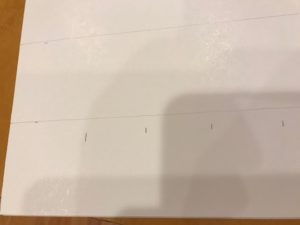
Draw the lines in pencil off of the markings you have made. Presto! The grid is done. (Look closely for the pencil lines. I draw them faint for my reference, not for the children.)
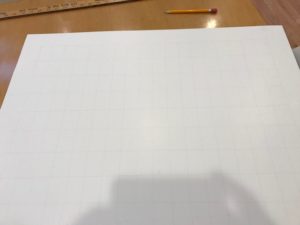
Now to put all of this into action!
Third Verse
First poster:
Melody Range
If I have 9 lines starting 2 inches up from the bottom, here is where I will place the first phrase of the 3rd verse. Each of the 9 divisions for note range are numbered 1, 2, 3, etc. faintly on the side so that I can see where to put the note.
He (6) is (2) al- ((1) ways (2) near (7) me (5) though (6) I (7) do (6) not (2) see (1) Him (2) there (3),
Notes in a Phrase
If I have 18 sections…
He is always near me (6 sections/spaces)
dotted quarter note (1 1/2 spaces), eighth note (half of a space), quarter note (space), quarter note (space), quarter (space), half note (two spaces),
though I do not see Him there, (8 spaces)
eighth (half space), eighth (half space), dotted quarter (1 1/2 spaces), eighth (half of a space), quarter (space), quarter (space), dotted half (3 spaces)
(Note: I’m only using 14 spaces out of the 18 I’ve marked off, but that just leaves some space at the end of the phrase and it is okay.)
Special Words
I will be putting a special visual symbol or color for the words I, me,He, His, not see, love, see/watchful/watching, care, and Him.
Why make a melody map?
A melody map with all of its symbols and discovering what the symbols mean is one of the most effective ways to teach a song to older children. They love codes and colors. They love discovering. The map helps the melody become visual. And it’s fun!

Joyce Newman
Thank you so much for sharing your musical expertise and creativity! My primary children have been the happy recipients of many of your ideas! You have taught me how to be more successful in this church calling!
Abby
I really want to do a map and have them decode it but I am really struggling with fully understanding it!
Sharla Dance
Dear Abby, The basic concept of a melody map is to visually graph out the melody of a song for the children. Along the way you can add something that represents significant words to that graph. Here are some other melody maps that you can search for on this site: Choose the Right, Article of Faith #5, As a Child of God, If I Listen with my Heart, Come Follow Me.
Perhaps looking at different examples (each very different from each other) might help to see by example of what kinds of things might be included on a melody map and what it kind of looks like.
Elisa Hammond
Is it best to use a melody map when first introducing a song, or is it also effective in solidifying a verse you’ve been working on or introducing another verse?
Sharla Dance
Dear Elisa,
I use a melody map for both of those purposes!
Marilee
Hello! Once I make the grid on the posters, can it be used as a template for other songs/melody maps? So I guess my question is…should I make the grid posters then laminate them for future use so I can re-use the grids over and over? 🙂
Sharla Dance
You can, but make more lines than you need both horizontally and vertically. Some songs have more notes or longer phrases.
Karen TUTOR
I love everything u present. Thank u so much. What a help iy is to me.
Emilee
I. Love. You. Thank you so much!!!! I’ve struggled for so long with melody maps, but you’ve mapped it out perfect for me. (Pun intended) THANK YOU!
Cindy
The lines above and below the highest and lowest notes of the song….you must
use that as part of the code?
Rachel Christensen
Thank you so much for the detailed descriptions. Do you color them on the poster, print them out and cut them, or use a punch? What are the sizes you like to use most?
Sharla Dance
I used to color them, then bought a large punch. I use a size big enough that people can see them at the back of the room. Thanks for asking!
Darla Broberg
Sharla, can you show an example of an abstract squiggle map? It sounds similar to a melody map, but I can’t quite wrap my head around it. And thanks for all your help — your ideas are marvelous!